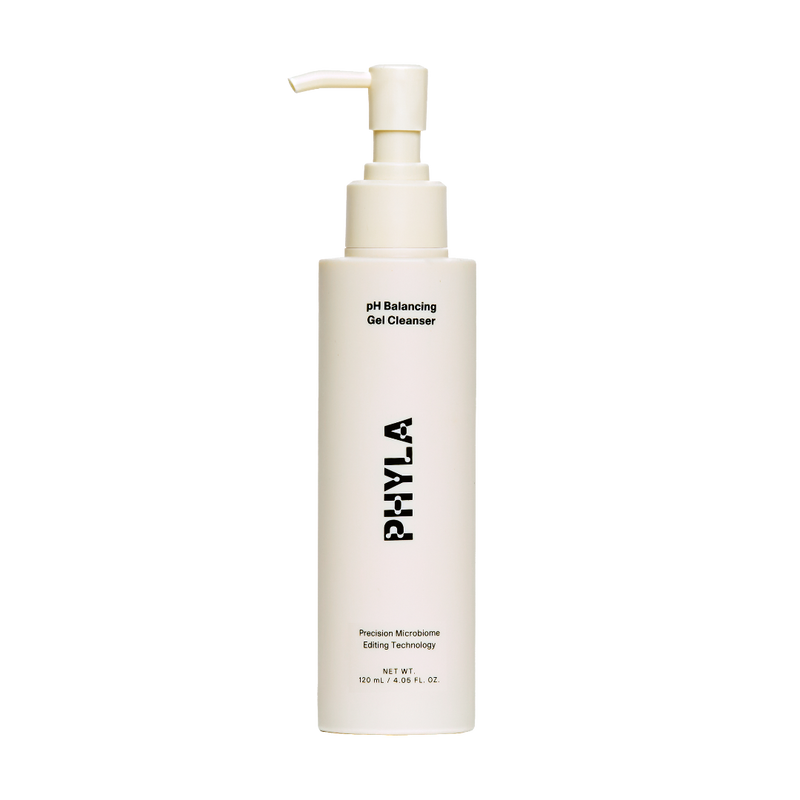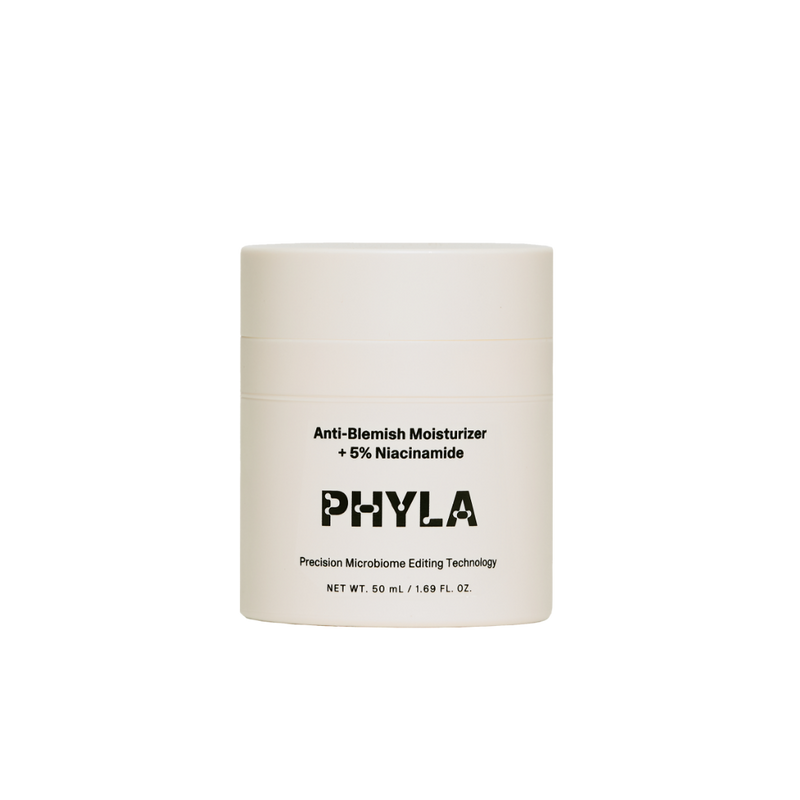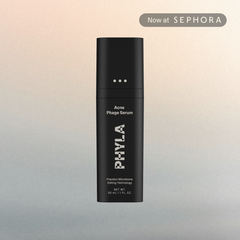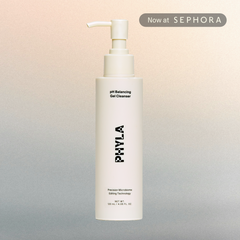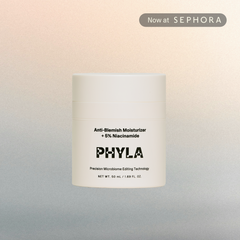How Do You Discover and Develop Your Probiotics?
Our discovery starts in our advanced biotech labs, where we have developed a platform to discover and catalog the hundreds and thousands of microorganisms in the skin microbiome. We noticed that one microorganism, a phage, seemed to be a key difference between samples from healthy skin and acne skin. Some of the latest microbiome research also points to these phages being a differentiating factor between healthy and acne skin.

Our discovery starts in our advanced biotech labs, where we have developed a platform to discover and catalog the hundreds and thousands of microorganisms in the skin microbiome. We noticed that one microorganism, a phage, seemed to be a key difference between samples from healthy skin and acne skin. Some of the latest microbiome research also points to these phages being a differentiating factor between healthy and acne skin. This led us to wonder whether the organism plays an active role in keeping skin blemish-free. You see, this phage naturally targets Cutibacterium acnes (C. acnes) with deadly efficiency, and C. acnes is the prime bacterial cause for acne. So what if this phage could help balance the microbiome by keeping this acne-causing bacteria in check, and provide a natural and gentle way to get blemish-free skin?
We collected a large library of C. acnes phages using our platform technology, and through full genome sequencing, we were able to check whether any potentially harmful behaviors were encoded in these phages. Phages have two types of lifecycles, or two ‘flavors’ – lytic and lysogenic. The lytic phages are always in ‘kill mode’, while the lysogenic phages have an additional ‘dormant mode’ that makes them slip into the bacteria’s genome, where it can make the bacteria more nasty and virulent. We only selected the obligatory lytic phages for our use, and we made sure that their genomes didn’t carry genes for antibiotic resistance.
Once we had a small group of phages with all these beneficial properties, we tackled the next challenge – how do we keep phages alive in formulation? All skincare and beauty products contain antimicrobial preservatives. This is necessary so your face cream or lotion doesn’t grow bacteria or mold once you open it, or while it’s sitting in your warm, humid bathroom. Unfortunately, these preservatives would also kill any probiotics that you might want to put in it. At this point, if you’re asking, “Wait, does that mean that my probiotic skincare doesn’t have any live cultures?”, well, that’s a blog post for another day.
Back to our problem: how can we keep these phages alive in a serum, without compromising on the safety of our products? First, we had to select the hardiest, most stable phages from our collection. We performed several assays and tests, and finally landed on our most stable phage – codenamed MEPA-012. Then we looked for other research on formulation with live phages, but there is almost no work that’s been done on this new type of probiotic. Thus, we had to start from scratch. We tested cosmetic ingredients one by one, to determine whether they were compatible with our phage. We first tested preservatives that would keep our phage alive. Luckily for us, since phages are metabolically inactive (kind of like the dormant bacteria in probiotic supplements), certain preservatives that target active metabolic processes were fully compatible with our phage. We built on these results and tested numerous oil phases, emulsion systems, emollients, humectants, and thickening agents. We finally built up a huge database of formulation know-how, which helped us understand not only how to stabilize our phage in a serum, but also how these ingredients affect our skin microbiome.
You see, we use a lot of products on our skin – it is estimated that women apply an average of 515 separate ingredients on their skin every single day. There is not much research on how these ingredients affect our microbiome, and our internal testing shows that many commonly used cosmetic ingredients kill beneficial members of our skin microbiome. Our focus is on minimizing the burden and effect of skincare ingredients, so that they care for the skin, and don’t suffocate it. To this end, we designed a system that you can use daily to control blemishes and breakouts, without any of the harsh side effects like redness, dryness, and irritation. We’ve designed each product with a minimalist ethos, and we don’t use any ingredient that’s on the banned list of cosmetic ingredients in Europe – a much more stringent list than the US. We recognize that cleansing, treating, and moisturizing are some of the basic functions of a daily skincare regimen. (Sunscreen is also very important, and we’re working hard to solve that need too!) In our testing, most moisturizers would kill the phage, and so if you moisturize right after applying the serum you wouldn’t see any benefits from our probiotic. We built our moisturizer to be light and hydrating – like a cloud – while preserving the phage on your skin. Thus, the system works in tandem to optimally support the integration of the live probiotic on your skin.
How do you test your probiotic?
Once we isolated and fully characterized the phage, we grew it up in order to incorporate it into the serum. This manufacturing process was developed fully in-house, using the advanced expertise of the founders in fermentation R&D and pharmaceutical biologics manufacturing. Starting from all vegetarian components, we developed and scaled a highly efficient manufacturing process to obtain a concentrated and highly purified phage stock. All our manufacturing processes are supervised and validated by a third-party quality inspection team, and we go over and above the requirements of cosmetic ingredients manufacturing by adopting more of a pharmaceutical-grade approach. This is part of our brand DNA, and it reflects the scientific roots of our products. You can find more technical details of our manufacturing and testing process here.
Our probiotic is tested for purity and identity by third-party labs, and all of this documentation is kept on file for every batch we make. The founders are instrumental in every step of this process, and their knowledge and obsessive attention to detail ensures that every batch meets the highest standards of quality and purity.
A critical part of testing is the safety of our products on human skin. Even though all our ingredients are certified green and cruelty-free, we perform extensive safety testing with volunteers to adhere to, and surpass, the industry standards. We use third-party services to provide unbiased safety testing results on all our products, and they have reported a perfect response (no irritation or sensitization) on 100% of subjects.
Since we have live phages in our serum, we take great care to ensure that the phages are at optimal levels at all times. The phages are extremely stable in refrigeration, but since they are a live culture they do have a more limited shelf life at room temperature. We have extensively tested and evaluated the stability of live phages in our serum at room temperature and elevated temperatures, as well as the effect of shipping on their potency. We are proud to report that the phages are extremely stable in all these scenarios. As such, we recommend that you keep the serum refrigerated until you use it, and then you can keep it at room temperature for your everyday use. We still recommend that you keep it refrigerated if you can, because it delivers a lovely cooling effect on your skin. This is especially welcome on inflamed or acne-prone skin, but in general, it provides your skin with relief and comfort at least once or twice a day.


